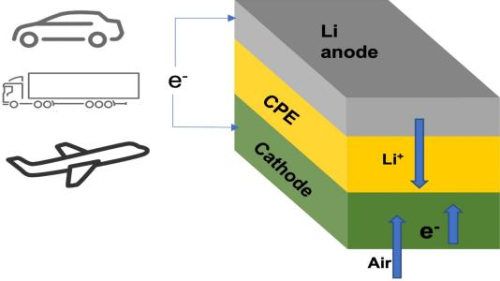The team’s battery chemistry with the solid electrolyte can potentially boost the energy density by as much as four times above lithium-ion batteries, which translates into longer driving range.
A lithium-air battery based on lithium oxide (Li2O) formation can theoretically deliver an energy density that is comparable to that of gasoline. Lithium oxide formation involves a four-electron reaction that is more difficult to achieve than the one- and two-electron reaction processes that result in lithium superoxide (LiO2) and lithium peroxide (Li2O2), respectively.
By using a composite polymer electrolyte based on Li10GeP2S12 nanoparticles embedded in a modified polyethylene oxide polymer matrix, we found that Li2O is the main product in a room temperature solid-state lithium-air battery. … The four-electron reaction is enabled by a mixed ion–electron-conducting discharge product and its interface with air.
—Kondori et al.
In past lithium-air designs, the lithium in a lithium metal anode moves through a liquid electrolyte to combine with oxygen during the discharge, yielding lithium peroxide (Li2O2) or superoxide (LiO2) at the cathode. The lithium peroxide or superoxide is then broken back down into its lithium and oxygen components during the charge. This chemical sequence stores and releases energy on demand.

Schematic shows lithium-air battery cell consisting of lithium metal anode, air-based cathode, and solid ceramic polymer electrolyte (CPE). On discharge and charge, lithium ions (Li+) go from anode to cathode, then back. (Image by Argonne National Laboratory.)
The team’s new solid electrolyte is composed of a ceramic polymer material made from relatively inexpensive elements in nanoparticle form. This new solid enables chemical reactions that produce lithium oxide (Li2O) on discharge.
The chemical reaction for lithium superoxide or peroxide only involves one or two electrons stored per oxygen molecule, whereas that for lithium oxide involves four electrons.
—co-author Rachid Amine
More electrons stored means higher energy density.
The team’s lithium-air design is the first lithium-air battery that has achieved a four-electron reaction at room temperature. It also operates with oxygen supplied by air from the surrounding environment. The capability to run with air avoids the need for oxygen tanks to operate, a problem with earlier designs.
For over a decade, scientists at Argonne and elsewhere have been working overtime to develop a lithium battery that makes use of the oxygen in air. The lithium-air battery has the highest projected energy density of any battery technology being considered for the next generation of batteries beyond lithium-ion.
—Larry Curtiss, an Argonne Distinguished Fellow and co-corresponding author
The team employed many different techniques to establish that a four-electron reaction was actually taking place. One key technique was transmission electron microscopy (TEM) of the discharge products on the cathode surface, which was carried out at Argonne’s Center for Nanoscale Materials, a DOE Office of Science user facility. The TEM images provided valuable insight into the four-electron discharge mechanism.
Past lithium-air test cells suffered from very short cycle lives. The team established that this shortcoming is not the case for their new battery design by building and operating a test cell for 1000 cycles, demonstrating its stability over repeated charge and discharge.
With further development, we expect our new design for the lithium-air battery to also reach a record energy density of 1200 watt-hours per kilogram. That is nearly four times better than lithium-ion batteries.
—Larry Curtiss
The research was funded by the DOE Vehicle Technologies Office and the Office of Basic Energy Sciences through the Joint Center for Energy Storage Research.